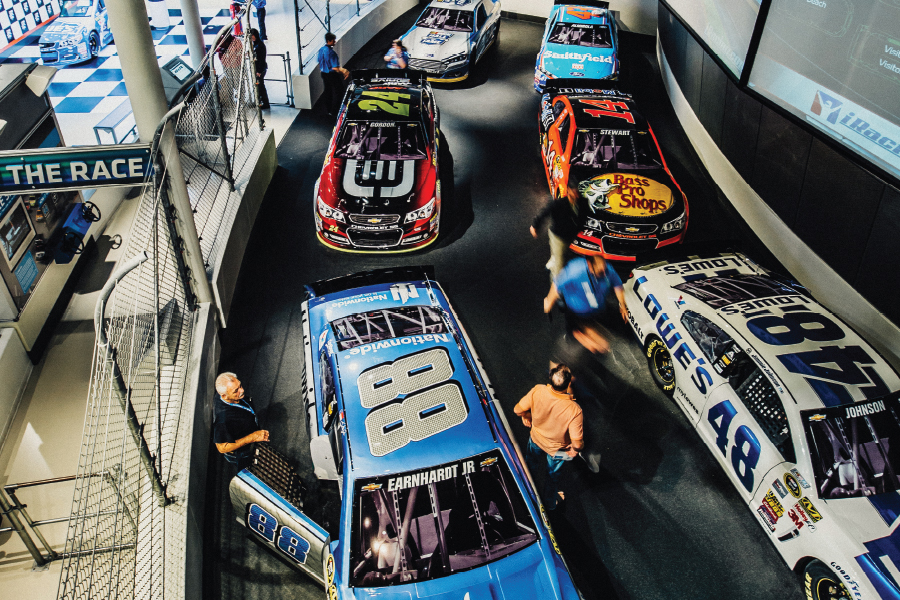6 Must-Do Charlotte Experiences
We sought unmistakably Charlotte experiences and found them in these popular locales. Here are six experiences exclusive to the Queen City.
by Allison Hancin
What makes a city unique? Man-made wonders offer adventurers and city explorers unparalleled attractions, while hometown spirit—especially the spirit of discovery—often lays the foundation for a metropolis’ future.

Fury 325 at Carowinds
Conquer the twists, turns and drops aboard the world’s tallest and fastest giga coaster: Fury 325, the 2016 winner of Amusement Today’s famed Golden Ticket Award for “Best Steel Coaster.” Thrill-seekers climb to a towering 325-foot peak—the city is visible in the distance—before dropping sharply at a hair-raising 81 degrees.
Seated on the North Carolina and South Carolina state line, Carowinds amusement park is the intersection of family fun and adventure. From record-breaking coasters to unique live shows, the “thrill capital of the Southeast” has maintained exclusive bragging rights since it opened in spring 1973.
The park is also home to Plants vs. Zombies Garden Warfare 3Z Arena, the world’s first “intra-active” 3-D digital experience, meaning the game allows you to interact with an opponent’s screen. During this shooter video game, guests on opposing teams—plants or zombies—battle it out to capture the ultimate treasure: the Golden Gnome.
Alongside these whirling additions, you’ll find a host of Carolina callouts in tried-but-true and new rides alike. With a hurdling track that seems to dive and soar like a fury of bees, Fury 325 serves as a nod to Charlotte’s “hornet’s nest of rebellion” reputation. The Carolinas Goldrusher—complete with carts designed like mine trains—hugs turns to mimic the excitement that swept the Charlotte region during the nation’s first gold rush. The sprawling Carolina Harbor waterpark, the largest waterpark in both states, exudes the characteristic charm of the Carolina Coast. Tidal Wave Bay’s 400,000-gallon wave pool mimics the surf of the Atlantic, while Blackbeard's Revenge, named for the infamous Tar Heel State pirate, boasts a harrowing six-story waterslide complex. In spring 2017, the park added the County Fair attraction, which combines vintage rides, classic festival fare and hearty doses of nostalgia to recreate the feel of an early-era Carolina carnival.

NASCAR Hall of Fame
The heart of racing beats at the NASCAR Hall of Fame. One of the city’s exclusive crown jewels, the Hall is dedicated to hailing the sport’s trailblazers and detailing their paths.
Located in Uptown, just 20 miles from Charlotte Motor Speedway, the Hall attracts fans and non-fans alike with a front-seat view into the world of professional racing.
Upon entering, guests marvel at the fabled race cars lining the Hall’s signature attraction: “Glory Road,” a curved life-size track. To give guests a feel for the different inclines found at NASCAR tracks across the country, the path up “Glory Road” showcases a spine-tingling ascent from zero to 33 degrees of banking. Revamped every few years, the exhibit’s current iteration, “ICONS,” includes 18 cars that have played indelible roles in NASCAR’s history. Among the treasures perched on “Glory Road,” you’ll find Davey Allison’s 1989 Thunderbird and Richie Evans’ 1939 Chevrolet Coupe.
In a building filled with fire suits worn by incredible drivers and trophies polished by proud teams, The Hall’s jewel is the Hall of Honor—a space dedicated to the members of the NASCAR Hall of Fame. Rare artifacts that represent each individual in the latest class take center stage in the display, but spires and audio stations located around the room pay tribute to every Hall of Famer ever inducted.
After paying your respects, experience NASCAR from all angles—as a driver, a member of the pit crew and as a fanatic—at each of the third floor’s hands-on “Race Week” stations. Put the pedal to the metal through a realistic racing simulator experience, or prepare a vehicle for race day glory in the beat-the-clock pit crew challenge. You can also retrace the sport’s evolution in “Heritage Speedway,” the fourth-floor exhibit that chronologically displays hundreds of artifacts from pre-NASCAR to present day. Don’t miss buzz-worthy stops like Junior Johnson’s moonshine still, also on the fourth floor, and the Whelen Hall of Champions, which details every champion from every series through NASCAR’s history.

U.S. National Whitewater Center
Home to the world's largest man-made whitewater river and an official Olympic Training site, the U.S. National Whitewater Center (USNWC) is an outdoor enthusiast’s dream, showcasing endless ways to explore by air, in water and on land.
Encompassing 1,300 acres that run along the banks of the Catawba River, the outdoor facility boasts multiple zip lines that will have you clutching your harness as you glide through the air. Overcome your fear of heights by conquering the 60-foot or 100-foot free fall jump. Or put your strength to the test as you travel from platform to platform through the canopy of trees in one of eight ropes courses.
Olympic hopefuls flock to the professional-level rapids to train in whitewater slalom racing. The USNWC was the site of the canoe and kayak slalom trials for the 2008, 2012 and 2016 Summer Olympic Games. Some giants of the sport, like Mount Holly resident Casey Eichfeld, even moved to the Charlotte area to be closer to USNWC before competing for their shot at gold. But those without Olympic dreams will still find adventure and thrill aboard the guided whitewater rafting course, which bills experiences to fit every skill level. Walk down a short trail to access the Catawba River, where stand-up paddleboarding and single and tandem kayaking await.
On land, the USNWC offers more than 30 miles of trails for running, walking and biking. The center is also home to one of the largest outdoor climbing walls in the South; at its max, it reaches 30 feet. For those itching for a new challenge, the USNWC features the world’s first permanent Deep Water Solo Climbing complex. Climbers scale an arched wall without ropes or harnesses, then release themselves into a 20-foot-deep pool.

The Billy Graham Library
Born in Charlotte in 1918, renowned evangelist Billy Graham was raised on his family’s dairy farm, just miles from what is now Charlotte Douglas International Airport. Throughout his 60-year ministry, Graham’s all-encompassing message of hope has reverberated throughout the world, reaching millions across the world and making him a household name.
The Billy Graham Library, located 4 miles from Graham’s original childhood homestead, serves as an educational and inspirational haven. The attractions feature 20 acres of tranquil grounds that whisper the story of Graham’s mission and legacy.
Through interactive exhibits, films and stories, guests retrace the origin and growth of Graham’s ministry along the Journey of Faith tour. Graham’s family home, where he lived from age 9 until college, was completely reconstructed and restored in front of the library with 80 percent of materials from his original home. The preserved structure and relics offers visitors an intimate glimpse into Graham’s upbringing. Other popular activities available on the grounds include spending time in the memorial prayer garden—where Graham’s wife, Ruth, is buried—shopping for gifts in Ruth’s Attic Bookstore, and polishing off milkshakes, ice cream sundaes and savory bites at the Graham Brothers Dairy Bar.
Since opening in 2007, the library has welcomed more than 1 million visitors from more than 90 countries. As part of its 10th anniversary celebration this year, the library will feature special events and exclusive displays from archived collections.
An annual must-see is Christmas at The Library, which draws crowds from near and far for a live nativity scene (cue real donkeys, lambs and camels), horse-drawn carriage rides, a traditional Christmas dinner with all of the trimmings and readings of favorite holiday stories. Destinations Magazine named the event one of the top 100 things to experience in North America via motorcoach.

Reed Gold Mine
Deep below the Uptown offices of Charlotte’s banking executives lies an intricate web of mining tunnels that are ultimately responsible for the rise of our banking city.
Twenty-five miles east of Charlotte, in Cabarrus County, Reed Gold Mine stands on the site of the country’s first documented gold discovery. It was here in 1799 that a young boy named Conrad Reed stumbled upon a 17-pound gold nugget in a stream bed while fishing. His luck inspired a city intent on finding more treasure, and that meant gold mines sprouting up by the dozen around the area—many in now-bustling Center City.
When Reed Gold Mine was founded on the land where Reed found luck, it helped lead the state in gold production until 1848. Today, that mine is a National Historic Landmark, and portions of its old underground tunnels have been restored and are open for the public to explore while they hunt for their own glistening bounty.
The mine’s exhibits feature historic items such as gold mining equipment and a 1890s ore-crushing stamp mill. Experience prospecting life for yourself during a self-guided tour of one of the underground mine tunnels, which date back to the 1830s. Your journey will allow you to appreciate the tedious work required to reap the reward of finding gold.
For an ultimate first-hand understanding of the Queen City’s ties to this twinkling treasure, be sure to pan for gold. Don’t expect to strike it rich, though; the last large gold nugget (100 pounds’ worth) to be discovered at Reed Gold Mine was unearthed in 1896.

Levine Museum of the New South
Charlotte’s growing skyline may showcase all things new and shiny, but the city’s roots run deep. A one-of-a-kind purveyor of the past and present, the Levine Museum of the New South, located in Uptown, celebrates the region’s storied history and looks to the future through hands-on education and thought-provoking exhibits.
The museum’s cornerstone exhibit, “Cotton Fields to Skyscrapers,” focuses on the history of the South since the Civil War. Guided by more than 1,000 audio recordings that include fascinating firsthand accounts and sound effects, plus artifacts, exhibits and incredible replicas, visitors explore Charlotte’s many reinventions. Step inside a tenant farmer’s one-room living quarters, hear the churning of a cotton mill or scoot up to a lunch counter that was paramount to the civil rights movement.
Telling other powerful stories, two of the museum’s past exhibits, “COURAGE” and “Changing Places,” were both recognized with Excellence in Exhibition Awards by the American Association of Museums, and portions of “COURAGE” appeared in South Africa’s Apartheid Museum, on display in Johannesburg, Cape Town and Durban.
The museum is the recipient of the federal government’s highest honor for museums, the National Award for Museum Service, which is awarded by the Institute of Museum and Library Services. In addition to receiving multiple grants, it has received tremendous praise from The New York Times.
The museum welcomes more than 50,000 visitors every year—each of whom leaves eager to help write the next chapter of the city’s fascinating story.











